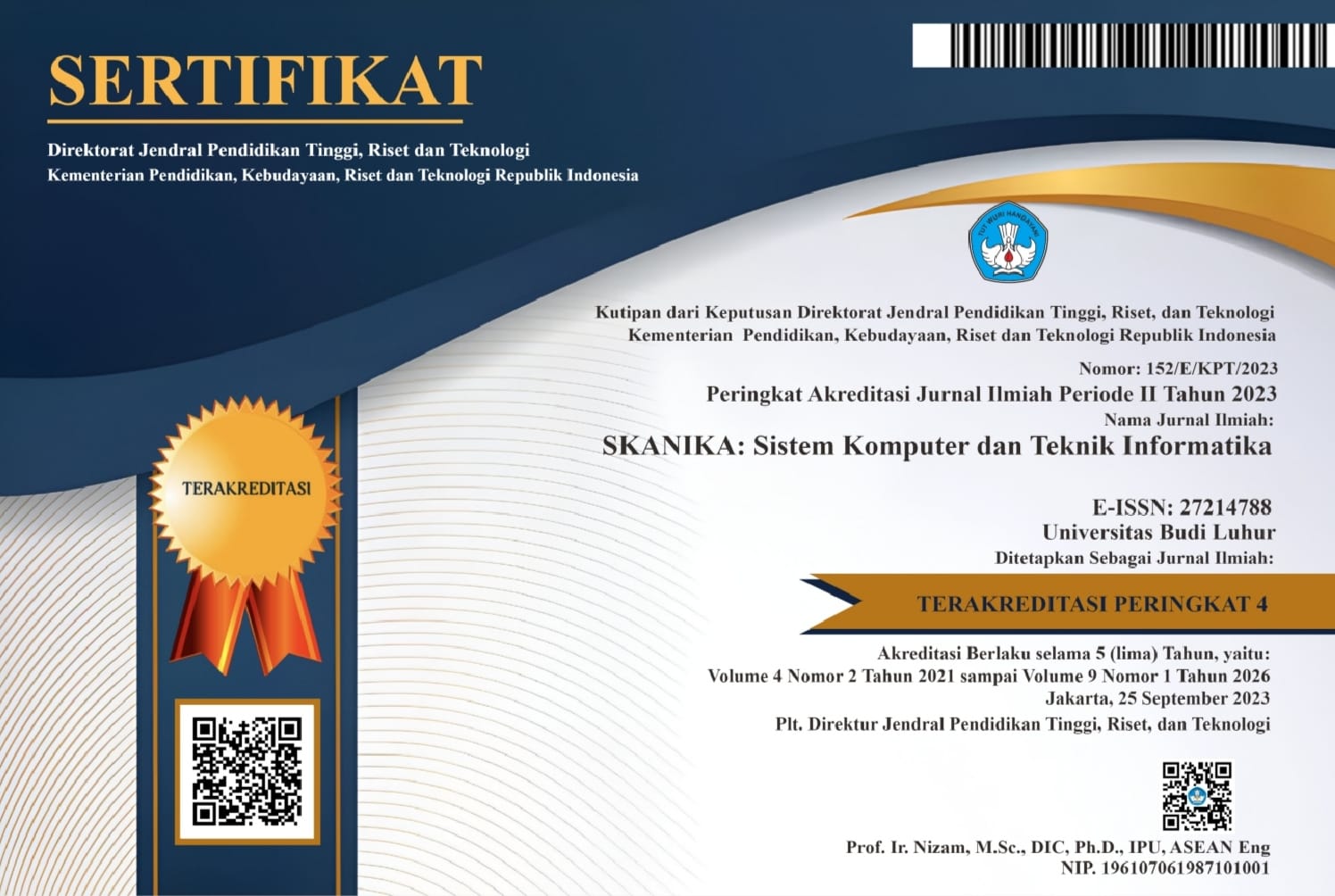EVALUASI DAMPAK OPPORTUNISTIC WIRELESS ENCRYPTION (OWE) TERHADAP KINERJA JARINGAN NIRKABEL IEEE 802.11AX
DOI:
https://doi.org/10.36080/skanika.v8i1.3295Keywords:
IEEE 802.1ax, Opportunistic Wireless Encryption, throughput, packet loss.Abstract
Security is a critical concern when using wireless networks, especially on open networks. Opportunistic Wireless Encryption (OWE) provides a solution to enhance protection on open wireless networks through encryption. This study evaluates the impact of OWE implementation on the performance of 802.11ax networks, focusing on metrics such as throughput and packet loss, compared to open security. An experimental approach was conducted in a client-server topology, measuring maximum throughput using the TCP protocol with packet sizes of 384 KB, 640 KB, and 1408 KB. Packet loss was also measured using the UDP protocol with data sizes of 10 MB, 100 MB, and 1000 MB. The results indicate that using OWE leads to performance degradation as packet size increases. Throughput decreases by 5–10 Mbps compared to open security, while the highest packet loss of 16% occurs with a bandwidth of 100 MB. These findings highlight that the encryption overhead in OWE affects performance, particularly with larger packet sizes. Despite the performance impact, OWE significantly enhances the security of open networks. However, the trade-off between performance and security should be carefully considered when implementing OWE in practical scenarios.
Downloads
References
[2] M. Natkaniec and N. Bieryt, “An Analysis of the Mixed IEEE 802.11ax Wireless Networks in the 5 GHz Band,” Sensors, vol. 23, no. 10, pp-1-34, 2023.
[3] G. Z. Islam and M. A. Kashem, “Efficient resource allocation in the IEEE 802.11ax network leveraging OFDMA technology,” Journal of King Saud University - Computer and Information Sciences, vol. 34, no. 2, pp. 1-9, 2022.
[4] S. Maesaroh, L. Kusumaningrum, N. Sintawana, D. P. Lazirkha, and R. D. O., “Wireless Network Security Design And Analysis Using Wireless Intrusion Detection System,” Intnational Journal Cyber IT Service Management, vol. 2, no. 1, pp. 30–39, 2022.
[5] M. A. Adiguna and B. W. Widagdo, “Analisis Keamanan Jaringan WPA2-PSK Menggunakan Metode Penetration Testing (Studi Kasus : Router Tp-Link Mercusys Mw302r),” Jurnal Sistem Komputer dan Kecerdasan Buatan (SISKOM-KB), vol. 5, no. 2, pp. 1-8, 2022.
[6] M. Y. Efendi and I. Riadi, “Analisis Perbandingan Metode Keamanan Wireless WEP 128bit Dan WPA Untuk Meningkatkan Keamanan Wireless,” Jurnal Sarjana Teknik Informatika, vol. 7, no. 1, pp. 63-68, 2019.
[7] D. Steiner-Otoo and H. Jahankhani, “An Investigation into How Smartphones Can Be Secured Against MiTM Attacks: Financial Sector,” in book series: Advanced Sciences and Technologies for Security Applications (ASTSA), pp. 171-215, 2022.
[8] I. Riadi, H. Herman, and A. Z. Ifani, “Prototype Pengembangan Aplikasi Login menggunakan Teknologi Blockchain,” Journal of Applied Informatics and Computer, vol. 5, no. 1, pp.1-8, 2021.
[9] S. Z. Mosawi, M. Qasimi, W. M. Wadeed, and K. R. Rahmani, “Exploring Wi-Fi Security Challenges and Proposing Solutions: The case of Afghanistan,” EJECE: European Journal of Electrical Engineering & Computer Science, vol 7, 5, pp. 1-19, 2023.
[10] A. Halbouni, L. Y. Ong, and L. M. Chew, “Wireless Security Protocols WPA3: A Systematic Literature Review,” IEEE Access, vol. xx, pp. 1-1, 2023.
[11] V. A. Saputro, S. Raharjo, and E. Pramono, “Pengaruh Wireless Security Protocol Pada Throughput Jaringan Wireless 802.11ax,” vol. 23, no. 2, pp. 1–7, 2021.
[12] T. M. Alghamdi, “Throughput Analysis of IEEE WLAN ‘802.11 ac’ Under WEP, WPA, and WPA2 Security Protocols,” International Journal of Computer Networks (IJCN), vol. 9, no. 1, pp. 1-13, 2019.
[13] R. Badhwar, “Next Gen Wi-Fi and Security,” in The CISO’s Next Frontier, 2021.
[14] S. Kwon and H. K. Choi, “Evolution of Wi-Fi Protected Access: Security Challenges,” IEEE Consumer Electronics Magazine, vol. 10, no. 1, pp. 74-81, 2021.
[15] G. D. Migration, “Planning Guide Appendix A : Documentation References.”
[16] Yusantono, “Analisis dan Perbandingan Jaringan WiFi dengan frekuensi 2.4 GHz dan 5 GHz dengan Metode QoS,” Journal of Information System Technology, vol. 05, no. 05, pp. 34–52, 2020.
[17] A. S. Amin, K. Harsanto, and R. Samsinar, “Implementasi Jaringan Kabel Dan Wireless Menggunakan Router Mikrotik Pada Sd Muhammadiyah 1 Jakarta,” SKANIKA: Sistem Komputer dan Teknik Informatika, vol. 5, no. 2, pp. 255–264, 2022.
[18] V. A. Saputro and S. Raharjo, “Pengaruh Penggunaan Beacon Interval Dalam Meningkatkan Throughput Jaringan Wireless IEEE 802.11ax,” Jurnal Sistem Komputer dan Kecerdasan Buatan (SISKOM-KB), vol. 6, no. 1, pp. 29-36, 2022.
[19] Z. Alamsyah, G. P. Insany, and F. J. Taqwana, “Perancangan Dan Implementasi Aplikasi Keamanan Ujian Online Menggunakan Algoritma Rijndael Dan Remote Desktop Protocol,” SKANIKA Sistem Komputer dan Teknik Informatika, vol. 7, no. 2, pp. 119–132, 2024.
[20] I. Priambudi and M. Mufti, “Implementasi Kriptografi Dengan Metode Aes-128 Untuk Pengamanan File Berbasis Web Pada Smp Yapipa,” SKANIKA: Sistem Komputer dan Teknik Informatika, vol. 6, no. 1, pp. 22–31, 2023.
[21] K. Murugesan, K. K. Thangadorai, and V. N. Muralidhara, “PoEx: Proof of Existence for Evil Twin Attack Prevention in Wi-Fi Personal Networks,” 2021 8th International Conference on Future Internet of Things and Cloud (FiCloud), Aug 2021.
Downloads
Published
How to Cite
Issue
Section
License
Copyright (c) 2025 Vian Ardiyansyah Saputro, Ariep Jaenul

This work is licensed under a Creative Commons Attribution-ShareAlike 4.0 International License.
CC BY-SA 4.0
Creative Commons Attribution-ShareAlike 4.0 International
This license requires that reusers give credit to the creator. It allows reusers to distribute, remix, adapt, and build upon the material in any medium or format, even for commercial purposes. If others remix, adapt, or build upon the material, they must license the modified material under identical terms.
BY: Credit must be given to you, the creator.
SA: Adaptations must be shared under the same terms.ng












